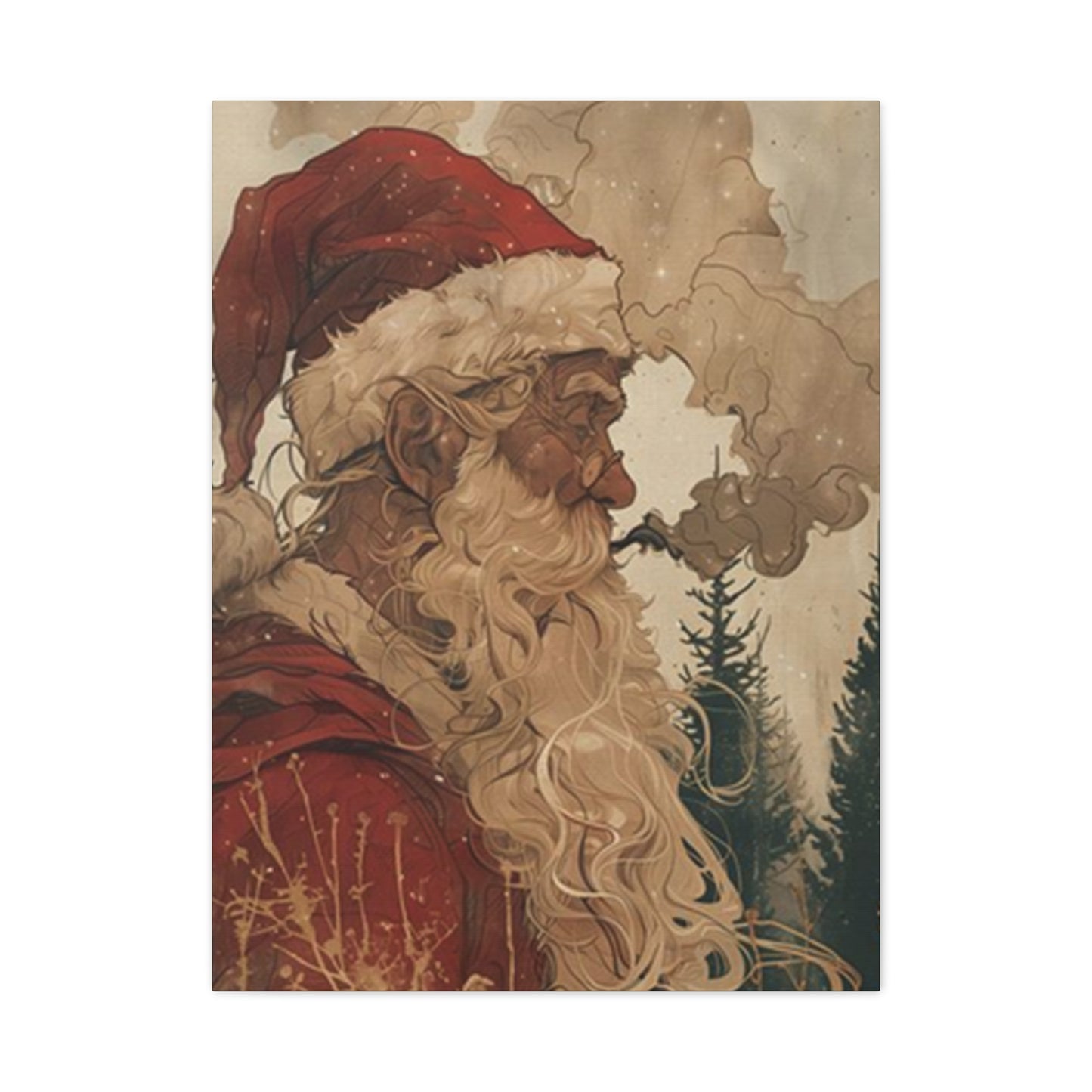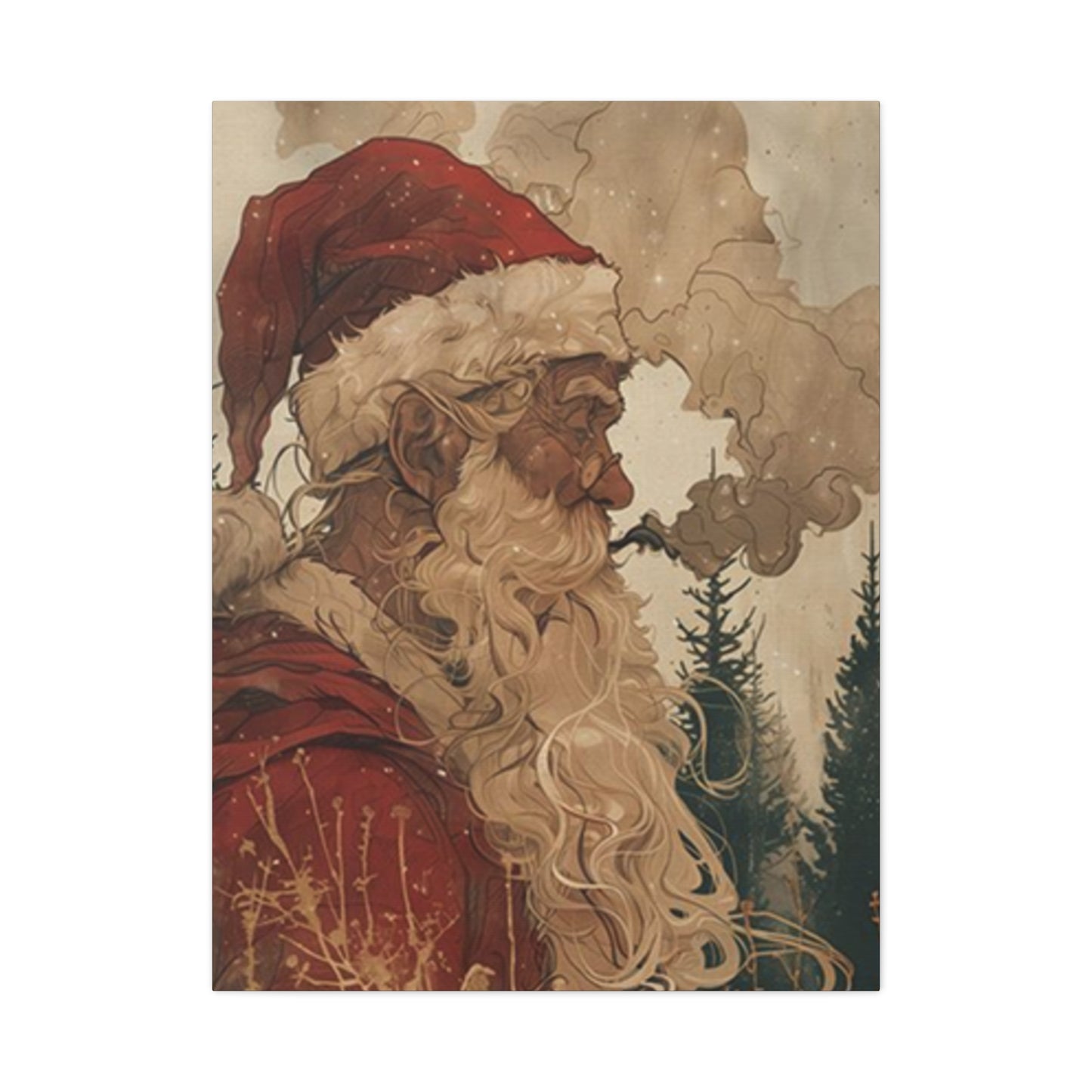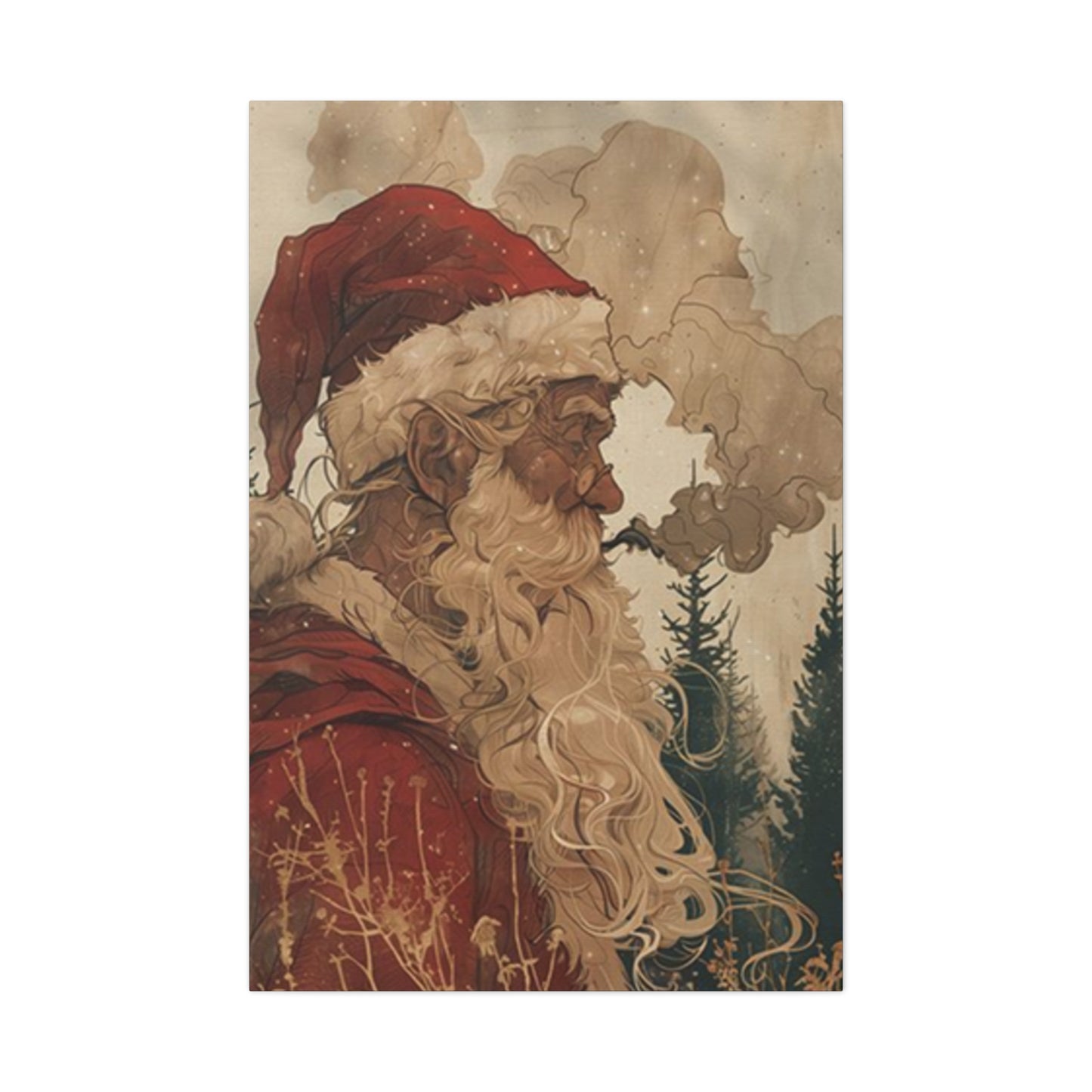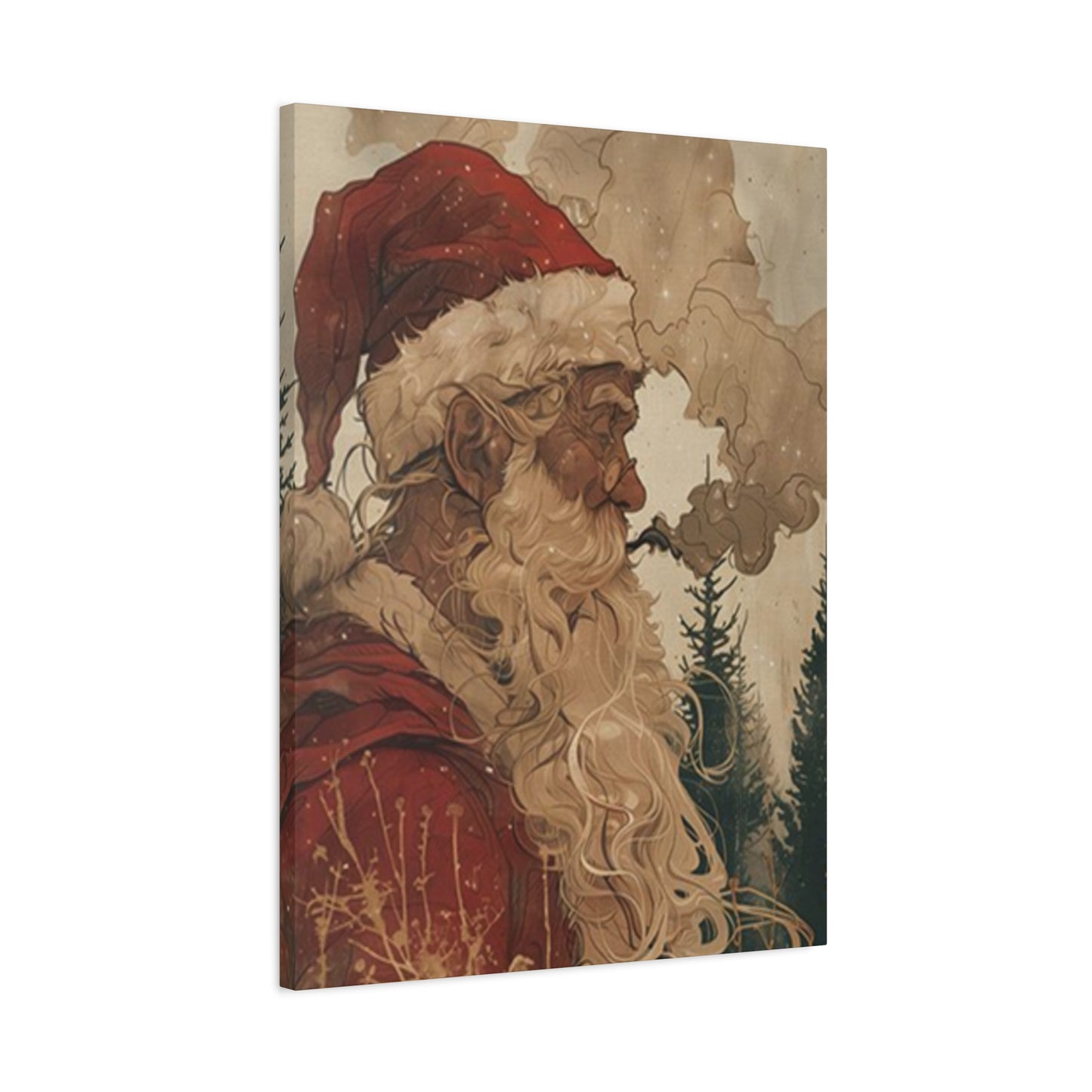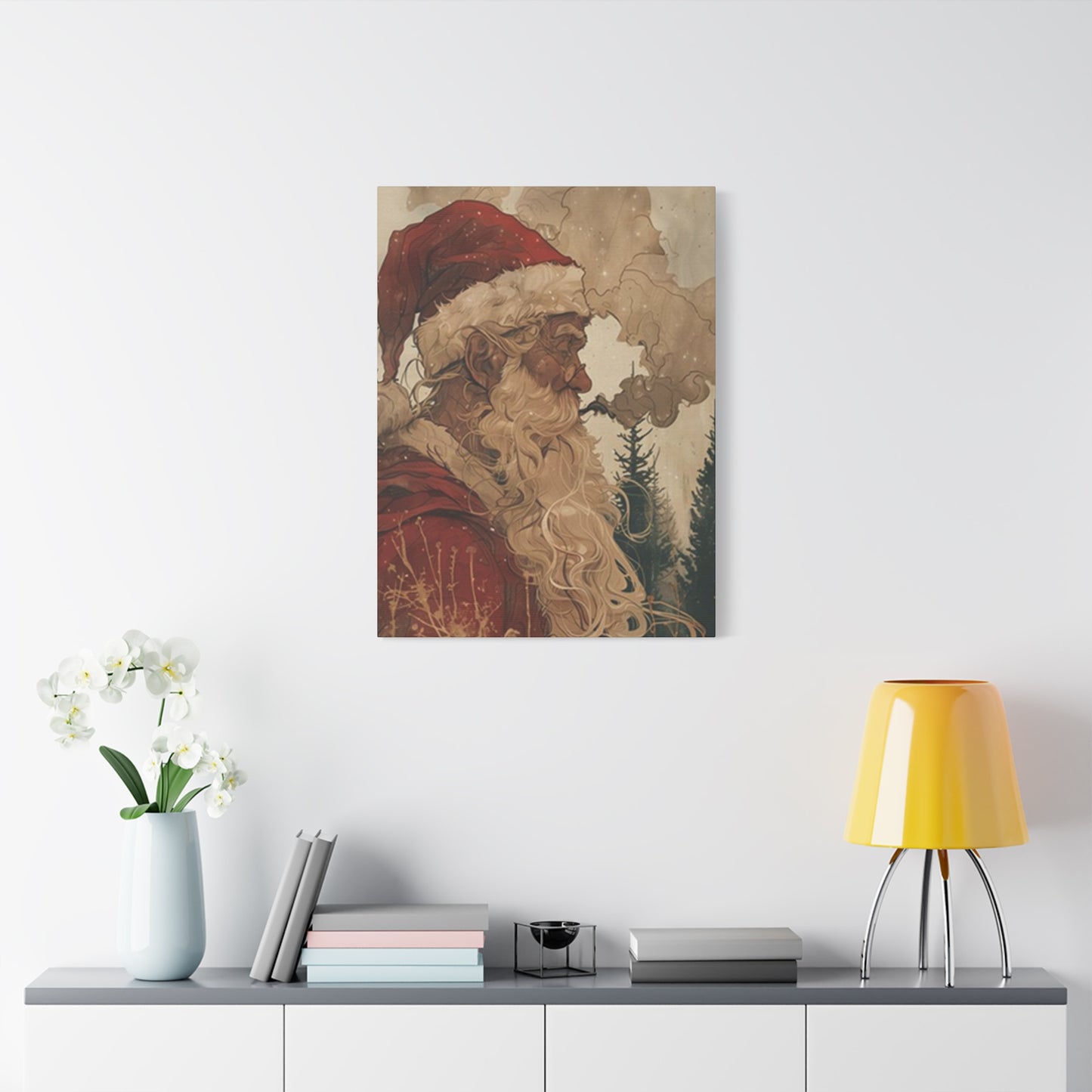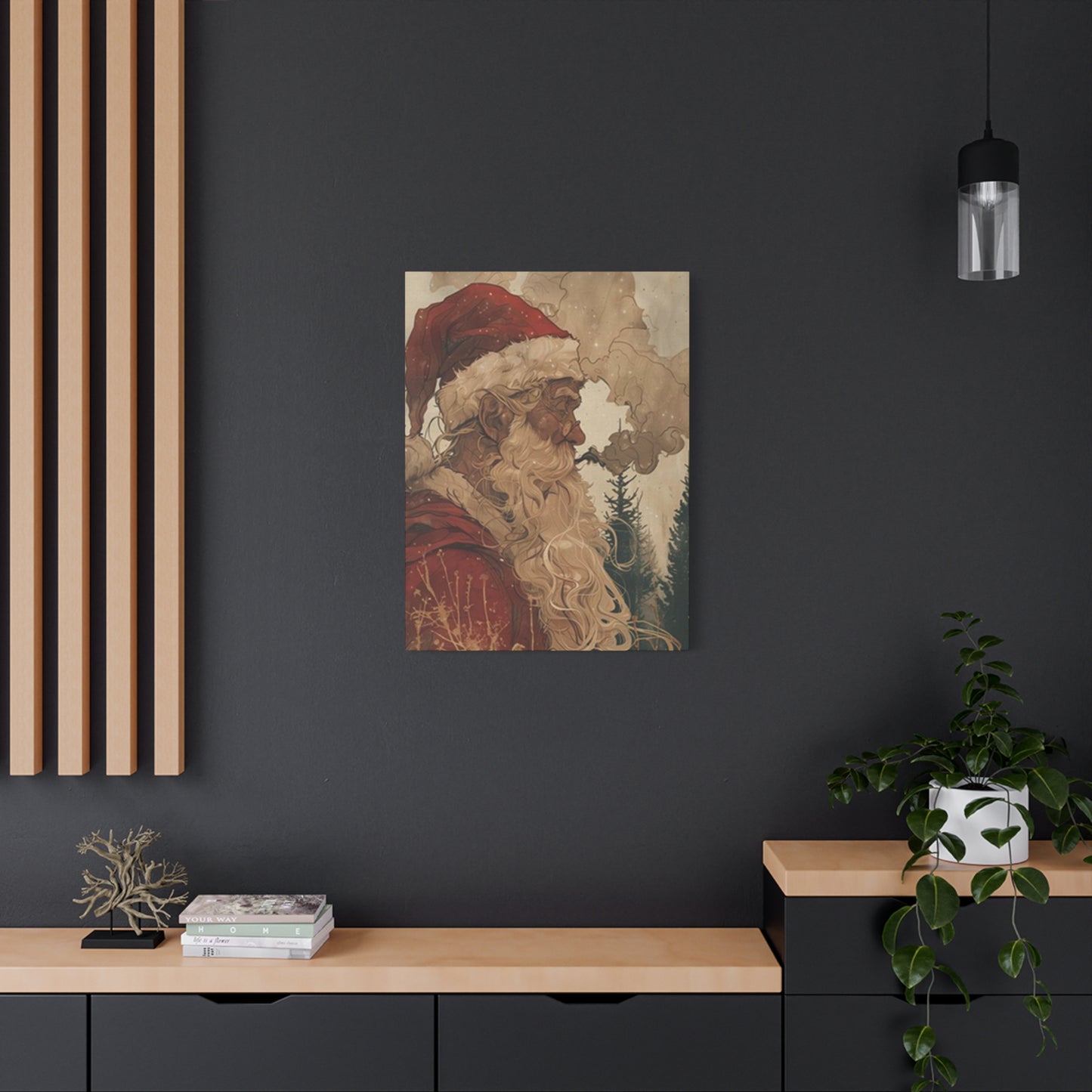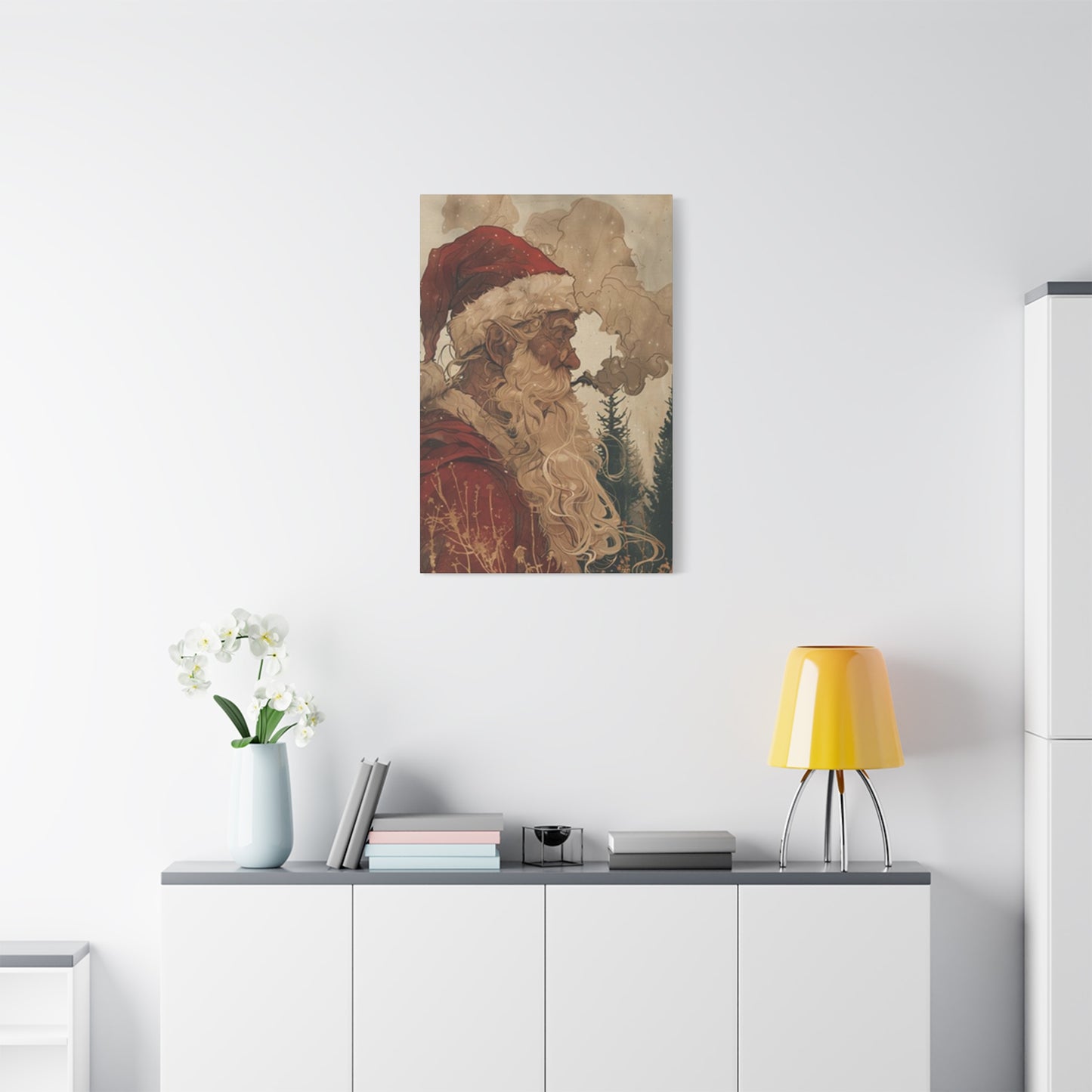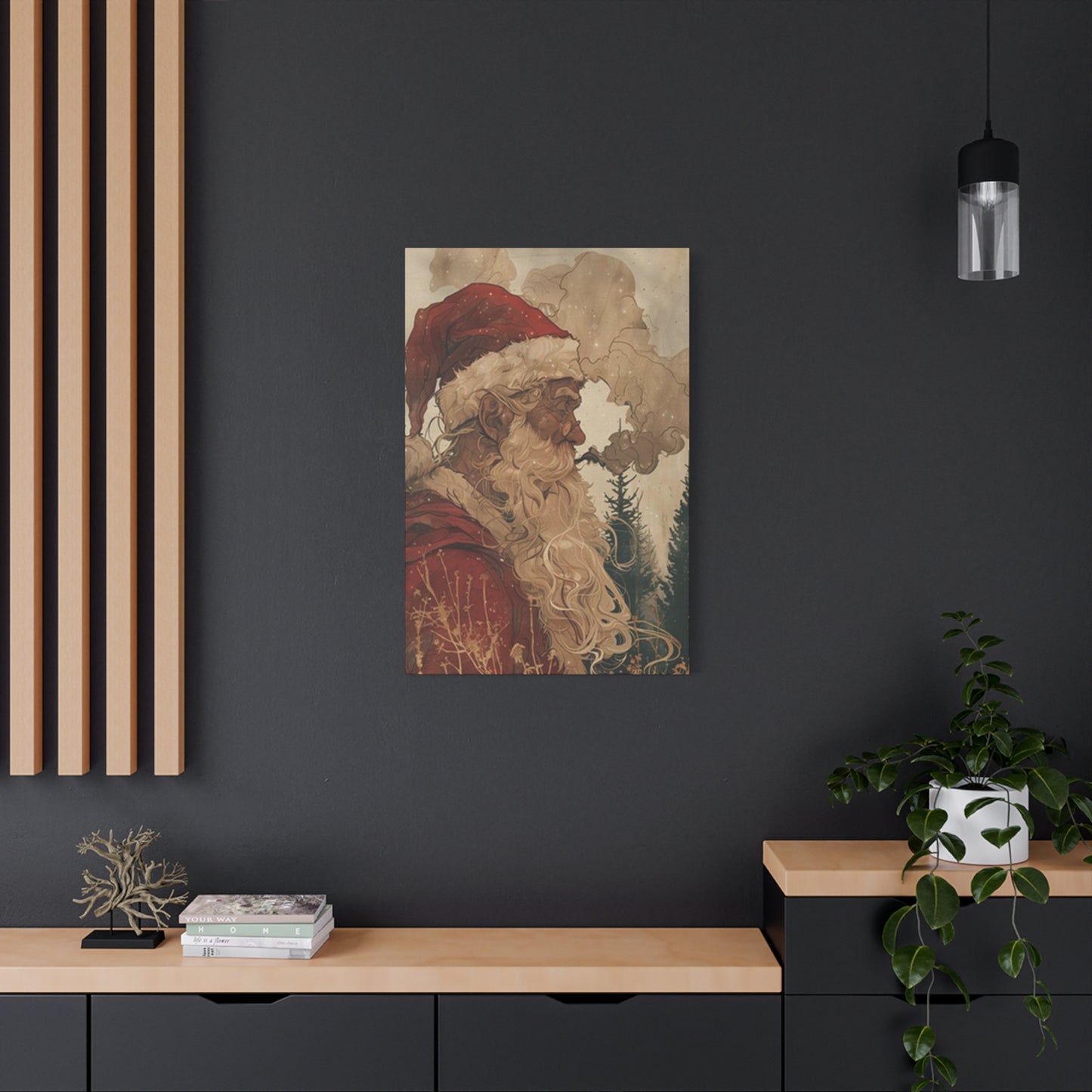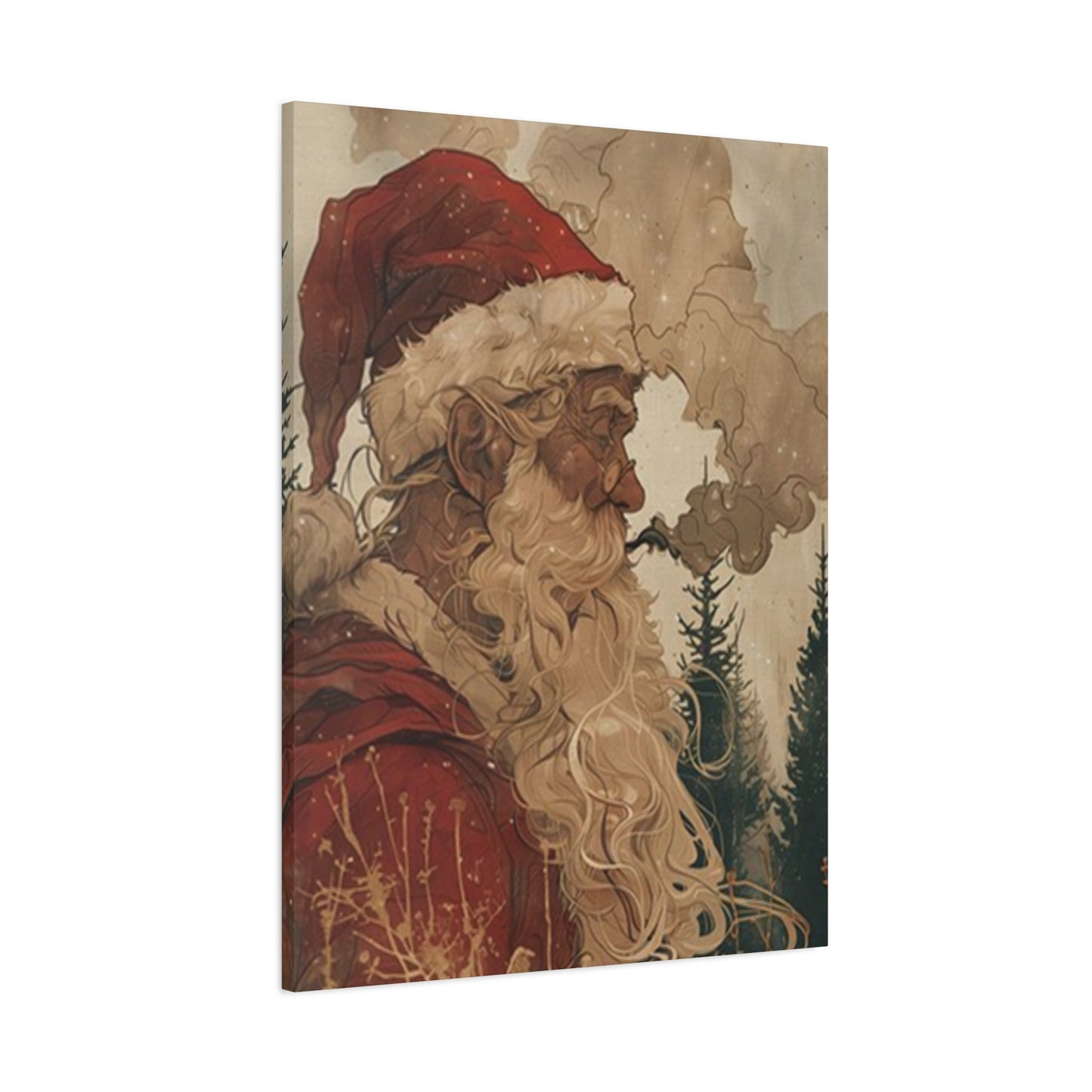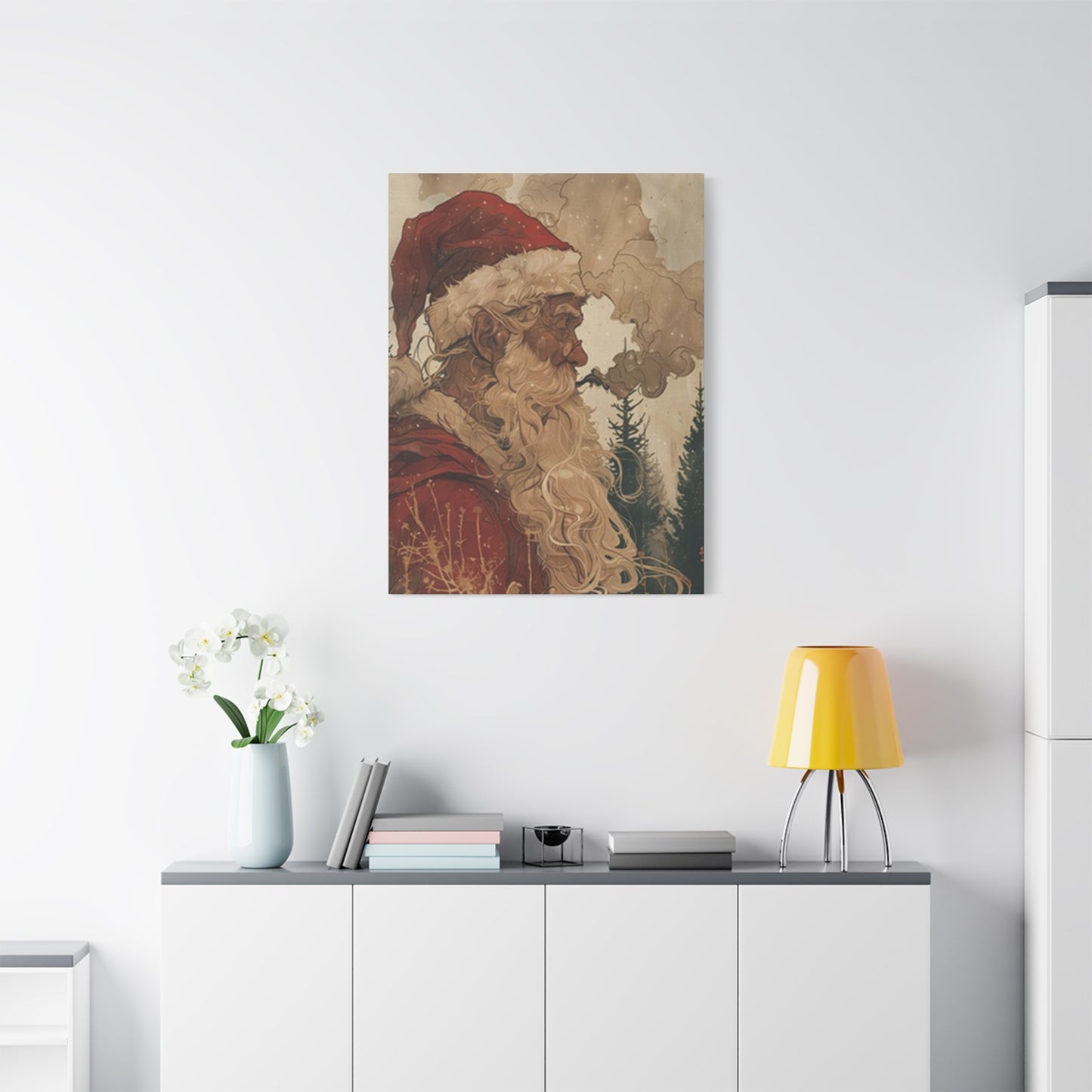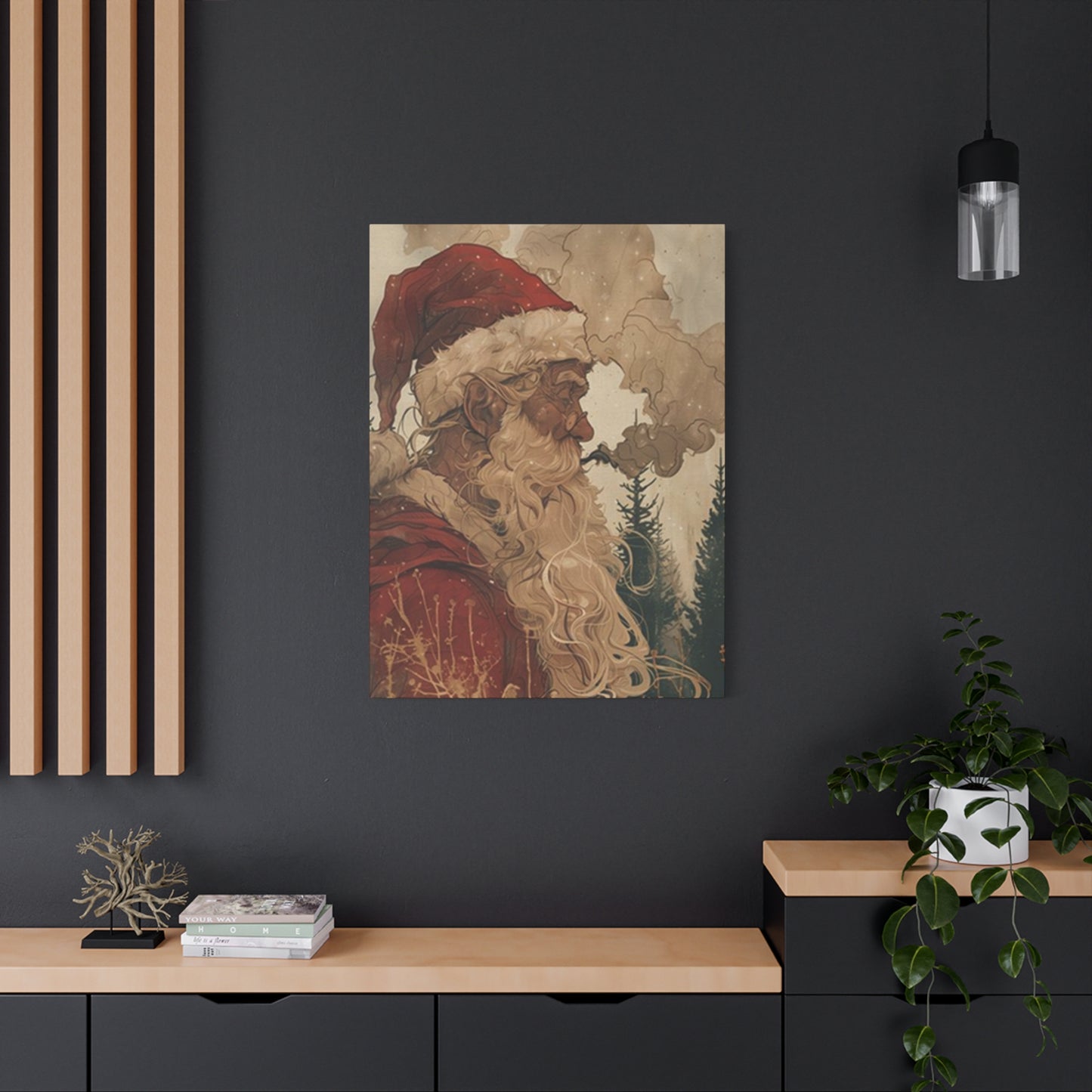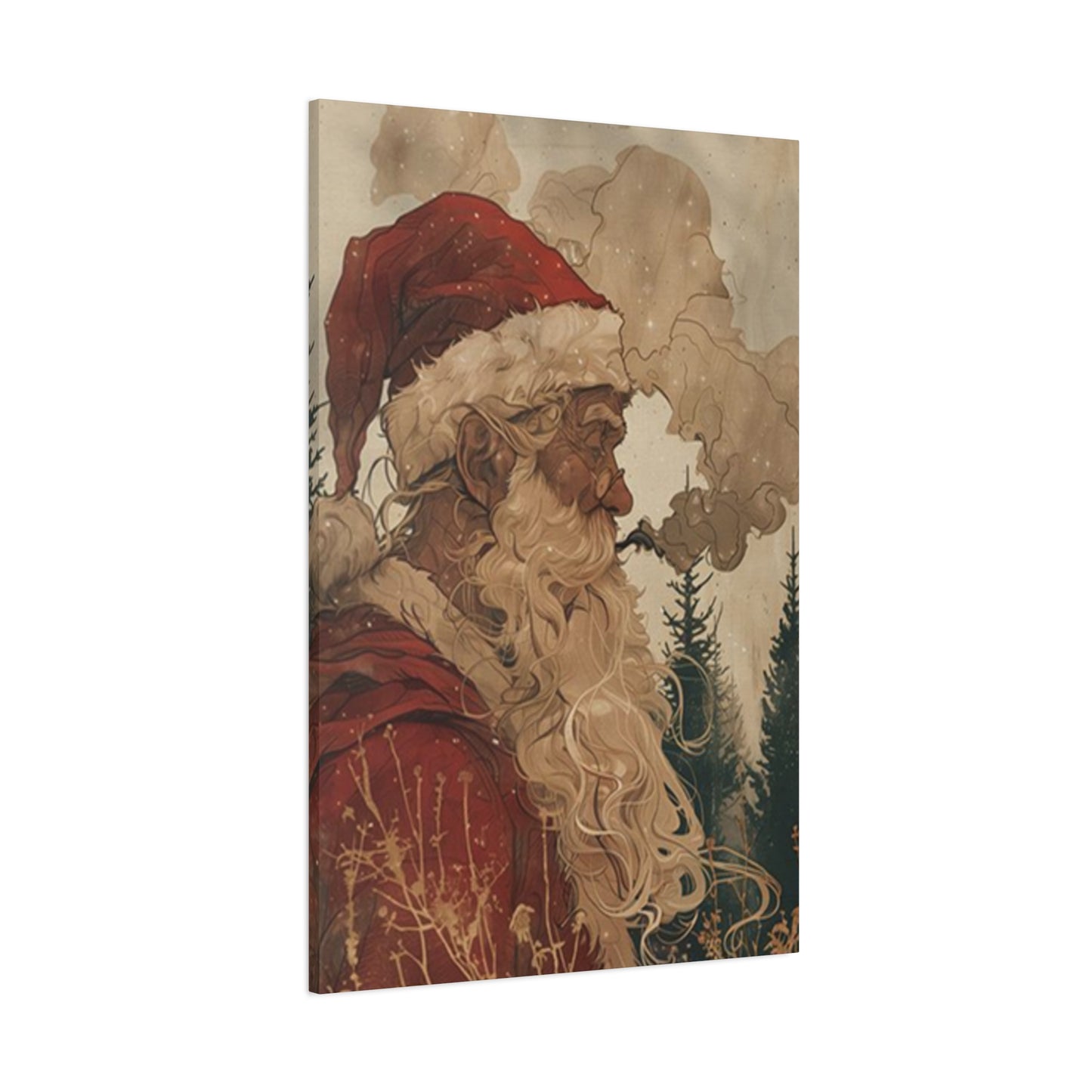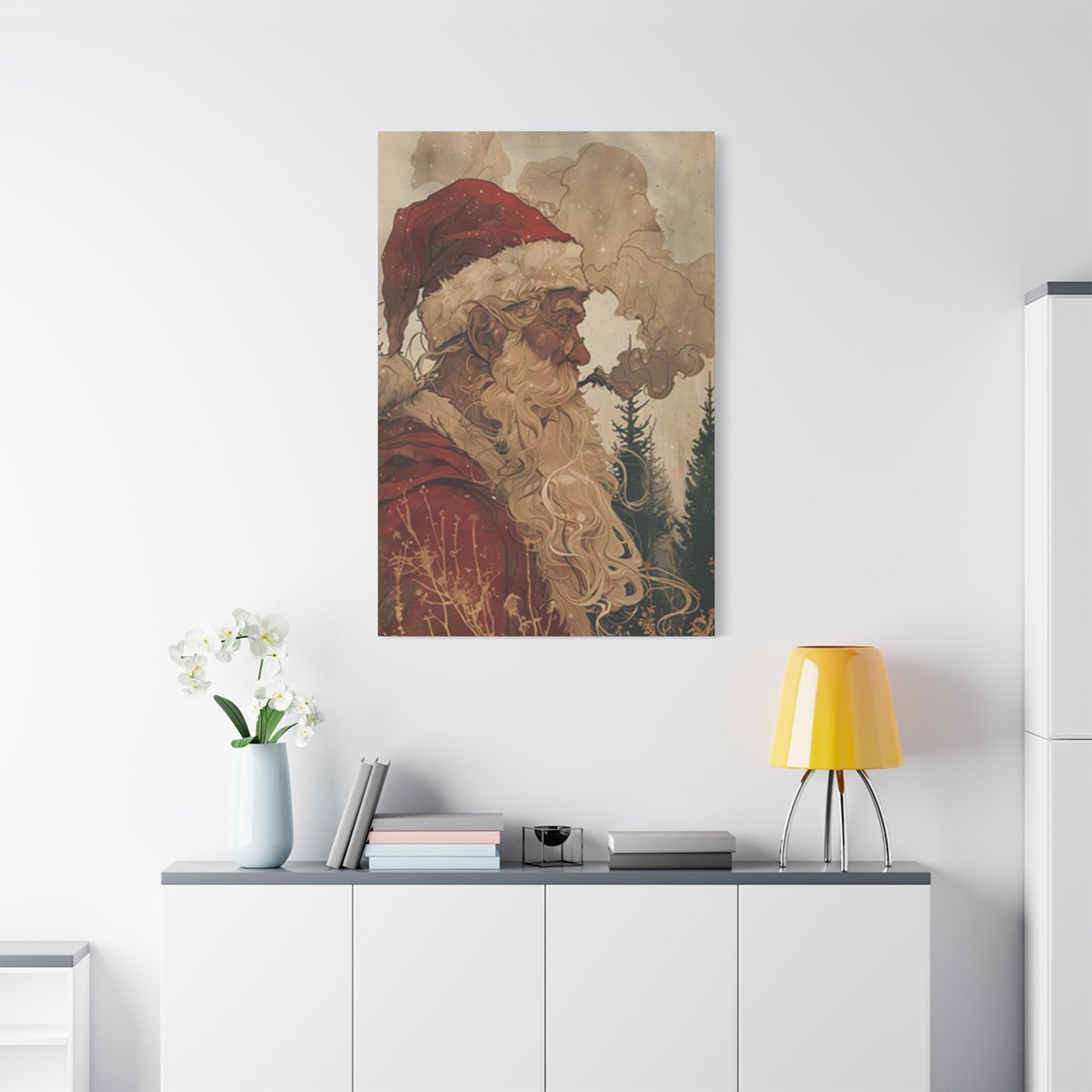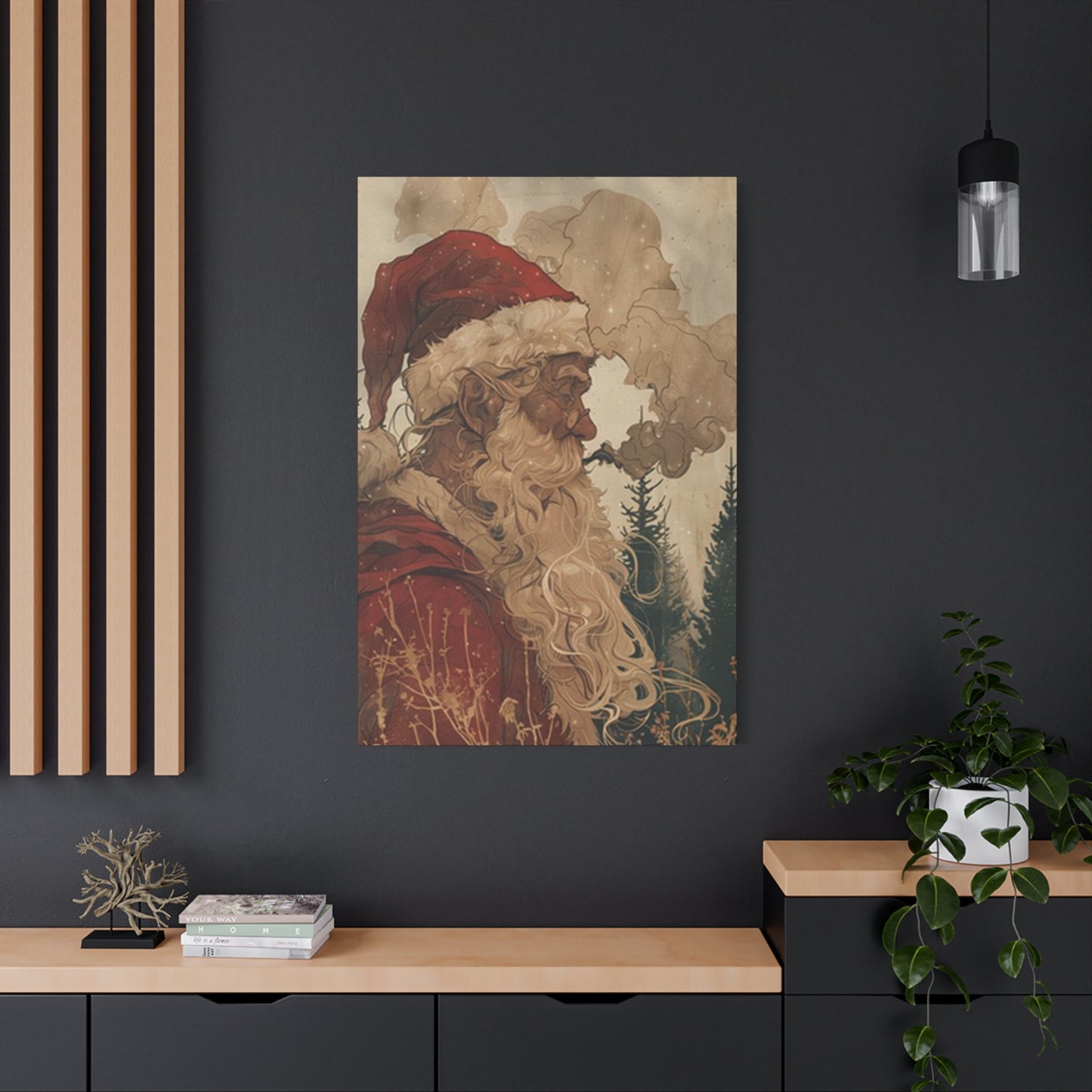Santa Claus Smoking Painting Wall Art: A Deep Dive into Subversive Holiday Decor
The image of Santa Claus is one of the most universally recognized and cherished symbols in modern culture. He is the embodiment of childlike wonder, generosity, and the magical spirit of Christmas. His iconography is meticulously curated: the jolly demeanor, the round belly, the flowing white beard, and the iconic red suit. This is the Santa we see in countless films, advertisements, and decorations that adorn our homes every winter. However, in the vast and ever-evolving world of art, icons are not merely meant to be revered; they are meant to be questioned, deconstructed, and reimagined. This brings us to a fascinating and provocative niche in contemporary decor: the phenomenon of Santa Claus smoking painting wall art. This specific genre of artwork takes the familiar, wholesome figure of St. Nicholas and places him in a context that is jarringly human, flawed, and decidedly adult.
By depicting Santa holding a cigarette or a pipe, artists create a powerful juxtaposition that challenges our preconceived notions and invites a deeper conversation. This art is not simply about shock value; it is a complex commentary on commercialism, the pressures of a beloved role, the nature of tradition, and the freedom of artistic expression. A painting of Santa Claus smoking is a statement piece in the truest sense. It can be interpreted as a humorous nod to the stress of delivering presents to the entire world in one night, a satirical critique of how corporate interests have shaped the holiday, or even a poignant reflection on the mortality and weariness hidden behind the myth. This exploration delves into the multifaceted world of Santa Claus smoking painting wall art, examining its historical context, artistic significance, psychological appeal, and its place within the broader landscape of home decor.
We will unpack the layers of meaning behind this seemingly simple, yet profoundly complex, image, understanding why it resonates with so many who seek to express a more nuanced, modern, and personal vision of the holiday season. This art form represents a departure from the saccharine sweetness often associated with Christmas, offering instead a more authentic, witty, and thought-provoking alternative. It is for the individual who appreciates irony, who finds beauty in the unexpected, and who believes that even the most sacred of icons can benefit from a touch of rebellious humanity. As we journey through the various facets of this artistic movement, we will uncover how a single, subversive image can encapsulate a wealth of cultural, social, and personal narratives, transforming a simple piece of wall art into a profound conversation starter.
Deconstructing the Icon: The Evolution of Santa Claus in Visual Culture
To fully appreciate the impact of a Santa Claus smoking painting wall art, one must first understand the journey of the Santa Claus icon itself. The figure we recognize today is not an ancient, immutable symbol but rather a relatively modern amalgamation of various historical figures, folklore, and, most powerfully, commercial art. The journey from a 4th-century Greek bishop to a global symbol of holiday cheer is a fascinating tale of cultural synthesis and artistic interpretation. The original figure, Saint Nicholas of Myra, was a pious and generous man known for his secret gift-giving. Early artistic depictions showed him as a stern, slender bishop in traditional clerical vestments, a far cry from the portly, joyful figure of today. For centuries, this was the dominant image associated with the gift-giver of winter.
Various European cultures had their own versions of a winter gift-bringer, from the British Father Christmas, who was more of a personification of feasting and merriment, to the Dutch Sinterklaas, who arrived on a steamboat and had a more disciplinarian edge. These figures were distinct in their appearance, backstory, and traditions. The transformation into the modern Santa Claus began in the 19th century, primarily in the United States. The 1823 poem "A Visit from St. Nicholas," more commonly known as "'Twas the Night Before Christmas," played a pivotal role. The poem described St. Nick as a "jolly old elf" with a "little round belly" and the ability to fly in a sleigh pulled by reindeer.
This text provided the foundational narrative and visual cues for a new, uniquely American version of the character. However, it was the hand of an artist that would truly cement his image in the public consciousness. The German-American cartoonist Thomas Nast, working for Harper's Weekly in the latter half of the 19th century, created a series of illustrations that brought the poetic descriptions to life. Nast was the first to consistently draw Santa as a large, cheerful man with a full white beard, living at the North Pole and meticulously keeping a list of naughty and nice children. He also standardized the red suit, although he sometimes depicted it in tan. The definitive, globally recognized image of Santa Claus was solidified in the 1930s through a series of advertising campaigns for a major beverage company.
The artist Haddon Sundblom was commissioned to create a wholesome, friendly Santa for their holiday promotions. Sundblom's paintings, which ran for over three decades, depicted a warm, grandfatherly figure with rosy cheeks, a twinkling eye, and an air of accessible benevolence. This was the Santa that became the standard, the image seared into the collective imagination. It is this highly polished, commercialized, and sanitized version of Santa Claus that subversive art directly engages with. The Santa Claus smoking painting wall art takes this perfected icon and deliberately introduces a flaw, a vice, a touch of weary realism. The act of smoking, often associated with stress, rebellion, or a bygone era of casual indulgence, directly contradicts the pure, child-friendly image created by Sundblom.
The Artist's Intent: Speculating on the Message Behind the Smoke
While the viewer's interpretation is a vital part of any artwork's meaning, it is also fascinating to speculate on the artist's original intent when creating a piece like a Santa Claus smoking painting wall art. What message might the creator be trying to send? While we can never know for certain without direct input from the artist, we can infer a range of possible motivations and messages that could be driving the creation of such a provocative image. One of the most straightforward intentions could be pure, unadulterated humor. The artist may have simply been struck by the comedic absurdity of the image—the ultimate symbol of childlike wholesomeness engaging in a very adult habit. In this case, the primary goal is to make the viewer laugh. The artist is acting as a jester, playfully poking fun at a revered figure.
There is no deep, hidden political message or scathing social critique. The intent is simply to create a piece of art that is witty, unexpected, and brings a moment of levity to the often-stressful holiday season. The message is simple: don't take things so seriously. A second, more critical intent could be social commentary, specifically aimed at the commercialization and labor behind Christmas. The artist might see themselves as a cultural critic, using their art to highlight the pressures and absurdities of the modern holiday. The smoking Santa becomes a symbol for the working class, the retail employee, or anyone who feels the strain of the holiday season. The artist's message could be a call for empathy and a reminder of the immense effort that goes into creating holiday magic. They may be saying, "Look at the man behind the curtain. He's tired, he's stressed, and he needs a break, just like you." This intent transforms the painting from a joke into a statement of solidarity with all those who work to make the holidays happen. A third possible intent could be a more personal, philosophical exploration of the nature of myth and reality.
The artist might be fascinated by the duality of Santa Claus—a magical, immortal being who is also, in our minds, a very human-like character. The act of smoking is a profoundly humanizing one, grounding the mythical figure in the mundane reality of everyday life. The artist could be exploring themes of mortality, imperfection, and the burden of being an icon. The message might be a poignant reflection on the loneliness of a figure who is universally loved but intimately known by no one. The intent here is not to be funny or political, but to evoke a sense of empathy and to prompt a deeper meditation on the stories we tell ourselves. Another motivation could be a desire to cater to a specific niche market. A commercially savvy artist might recognize that there is a growing audience for alternative, edgy, and non-traditional holiday decor. They might intentionally create the Santa Claus smoking painting wall art to appeal to this demographic of consumers who are looking for something different. In this case, the intent is less about personal artistic expression and more about market-driven creation.
The message is tailored to the audience, reflecting their own ironic and rebellious sensibilities back at them. The art becomes a product designed to meet a specific consumer demand for "cool" and unconventional holiday items. Finally, the artist's intent could be a simple act of artistic freedom and rebellion. In a world saturated with saccharine holiday imagery, the artist might feel a creative compulsion to create something that breaks the mold. The act of painting a smoking Santa could be a personal statement against artistic conformity and a celebration of the freedom to reinterpret any subject matter. The message is directed not just at the viewer, but at the art world itself. It is a declaration that no icon is too sacred to be reimagined, and that the role of the artist is to challenge, question, and provoke. Speculating on these various intentions reveals the rich potential of the artwork. Whether conceived as a simple joke, a sharp critique, a poignant portrait, a commercial product, or an act of rebellion, the Santa Claus smoking painting wall art remains a powerful and multifaceted piece, its smoky haze filled with a multitude of possible messages.
A New Holiday Tradition? The Enduring Appeal of Alternative Christmas Decor
The phenomenon of the Santa Claus smoking painting wall art is part of a much broader trend: the rise and enduring appeal of alternative Christmas decor. For generations, holiday decorating was guided by a relatively narrow set of traditional aesthetics. Think red and green color palettes, classic ornaments, nativity scenes, and wholesome, family-friendly imagery. However, in recent years, there has been a significant shift towards more personalized, diverse, and unconventional decorating styles. This movement away from a one-size-fits-all approach to Christmas reflects deeper changes in our culture and values, and it suggests that the "new traditions" of today may become the cherished classics of tomorrow. One of the main drivers of this trend is the desire for personal expression. In an age of social media where individuals curate their lives for public consumption, the home has become the ultimate backdrop for self-expression.
People are no longer content to have their homes look like a generic page from a department store catalog. They want their spaces to reflect their unique personalities, interests, and sense of humor. Alternative Christmas decor allows them to do just this. A black Christmas tree, a set of horror-themed ornaments, or a painting of a smoking Santa are all ways of infusing the holiday with a distinct personal flavor. It is a way of saying, "This is my Christmas, and it looks the way I want it to." This trend is also fueled by a growing diversity of family structures and beliefs. The traditional image of Christmas is often centered around a very specific type of nuclear family and a Christian religious framework. However, modern households are incredibly diverse. There are single-person households, child-free couples, multi-generational families, and people from a wide range of religious and secular backgrounds. For many, the traditional decor does not reflect their lived reality. Alternative decor provides options that are more inclusive and adaptable.
A secular household might prefer ironic or pop-culture-themed decorations over religious ones. A young urban couple might opt for a minimalist, modern aesthetic rather than a rustic, traditional one. Alternative decor allows people to participate in the festive season in a way that feels authentic to them. Humor and irony have also become central components of modern holiday celebrations, particularly for younger generations. The internet has fostered a culture that thrives on memes, satire, and a certain level of self-aware cynicism. This sensibility naturally extends to holiday decorating. Pieces like the Santa Claus smoking painting wall art tap directly into this cultural mood. They acknowledge the stress and commercialism of the holiday with a wink and a nod. This ironic approach provides a sense of relief and camaraderie, a shared understanding that the holidays are wonderful but also kind of absurd. This humorous, less-reverent approach is, for many, a new and cherished holiday tradition in itself.
The market has been quick to respond to this demand. What started as a niche movement, with items found only on specialty websites or in small artist-run shops, has now hit the mainstream. Major retailers are increasingly offering "alternative" holiday collections, featuring unconventional colors, quirky themes, and humorous items. This commercial embrace signals that alternative decor is no longer a fringe trend but a significant and enduring part of the holiday market. The enduring appeal of alternative Christmas decor, including the smoking Santa, lies in its ability to empower individuals. It frees them from the pressure of conforming to a single, often unattainable, holiday ideal. It allows them to be creative, to be humorous, and to be authentic. While traditional decorations will always have their place, the growing popularity of alternative styles suggests that the future of holiday decorating is one of choice, diversity, and personal expression. The act of choosing a rebellious piece of art for the wall is, in itself, becoming a new holiday tradition—one that celebrates individuality as much as it celebrates the season.
Playful Holiday Wall Décor
Playfulness in decorative art brings lightness and joy to living spaces, creating environments that feel welcoming and unpretentious. Holiday décor particularly benefits from playful approaches, as the season itself celebrates joy, wonder, and childlike excitement. However, playful doesn't necessarily mean childish; sophisticated examples incorporate wit, clever design, and artistic quality that appeals to adult sensibilities while maintaining a sense of fun and spontaneity.
Wall décor that embraces playful themes often features unexpected elements, creative interpretations, or humorous details that reward close examination. These pieces invite interaction and engagement, encouraging viewers to look beyond surface impressions and discover layered meanings or clever references. The best examples balance entertainment value with aesthetic merit, ensuring they function successfully as both conversation pieces and legitimate artworks that enhance their surroundings.
The versatility of playful holiday wall décor makes it suitable for various settings and design schemes. While obviously at home in casual, eclectic environments, well-executed pieces can also function effectively in more refined spaces when thoughtfully integrated. The key lies in matching the specific artwork's style and tone to the surrounding environment and ensuring that playfulness enhances rather than undermines the overall aesthetic. Consider existing color schemes, furniture styles, and the general atmosphere you wish to create.
Material quality and production techniques significantly impact how playful artwork is perceived. Pieces printed on cheap materials or poorly executed often appear tacky regardless of conceptual cleverness, while the same designs rendered on quality canvases with professional techniques can look sophisticated and intentional. This distinction is crucial for buyers who want playful artwork that maintains dignity and doesn't cheapen their spaces. Investing in proper materials and skilled production ensures that playful pieces command respect and maintain their appeal over time.
Santa Claus in Artistic Humor
Artistic humor represents a sophisticated form of comedy that operates through visual means, relying on composition, symbolism, and cultural reference rather than explicit jokes. When applied to iconic holiday figures, this approach yields rich, multilayered artworks that function on several levels simultaneously. Viewers might initially respond to obvious humorous elements before discovering subtler jokes, references, or commentaries embedded in the composition. This depth separates artistic humor from simple gags or novelties.
The technique of creating humorous yet artistically valid work requires considerable skill and conceptual sophistication. Artists must balance entertainment value with aesthetic quality, ensuring that neither element overwhelms the other. They carefully consider composition, color relationships, lighting, and detail level just as they would for serious work, while simultaneously crafting scenarios or including elements that provoke amusement. This dual focus produces artwork that satisfies both intellectually and emotionally.
Cultural context plays an important role in how humorous artwork is received and interpreted. References that resonate strongly in one community might fall flat in another, making it important for buyers to consider their intended audience when selecting pieces. The most universally successful examples rely on broadly recognizable situations or emotions rather than narrow cultural specifics. They find humor in fundamental human experiences and behaviors that transcend particular demographics or backgrounds.
Display strategies for artistically humorous pieces should consider both the artwork's strengths and the viewing context. Proper placement ensures that details remain visible and the composition can be appreciated fully. Lighting should illuminate the piece without creating glare or washing out subtle color variations. Consider sight lines and viewing distances to ensure that both casual glances and careful examination reveal the artwork's qualities. Thoughtful presentation maximizes the piece's impact and demonstrates respect for its artistic merit alongside its entertainment value.
Festive Yet Edgy Canvas Prints
The combination of festive themes with edgy aesthetics creates a compelling tension that appeals to modern sensibilities. This approach acknowledges traditional holiday joy while incorporating contemporary attitudes that value authenticity, individuality, and willingness to challenge conventions. The result is artwork that honors the spirit of celebration while refusing to be constrained by outdated expectations or overly sanitized representations. This balance makes such pieces particularly appealing to buyers seeking meaningful connections to holiday traditions without sacrificing their personal style or values.
Edgy aesthetics in canvas prints often manifest through unconventional subject matter, unexpected stylistic choices, or bold artistic decisions that distinguish the work from mainstream offerings. These might include dramatic lighting, gritty textures, unconventional color schemes, or scenarios that acknowledge the complexities and contradictions inherent in modern life. The edge comes not from shock value alone but from genuine artistic vision that sees beyond surface-level interpretations to find deeper, more interesting truths.
The technical execution of edgy festive canvas prints requires particular attention to ensure that boldness doesn't cross into crudeness. High-quality printing processes preserve intentional graininess or texture while maintaining overall clarity and impact. Color management ensures that moody palettes remain rich rather than muddy, and that subtle tonal variations are preserved. Proper canvas treatment and stretching maintain the artwork's professional appearance and prevent technical issues from undermining the artistic vision.
Collectors drawn to edgy festive artwork typically value authenticity and self-expression above conformity. They appreciate pieces that reflect their complex relationship with holiday traditions, honoring the positive aspects while acknowledging that real celebration involves imperfect, authentic human experiences. These buyers often display such artwork year-round rather than relegating it to storage after the season, as they view it as legitimate art that happens to incorporate holiday themes rather than temporary seasonal decoration.
Santa Captured in Winter Scenes
Winter landscapes provide atmospheric backdrops that enhance the visual impact of character-focused artwork. These settings establish mood, suggest narrative context, and create environmental realism that grounds even fantastical subjects. The combination of recognizable seasonal elements with unconventional character portrayals results in artwork that feels both familiar and surprising, comfortable and provocative. This duality makes winter scene compositions particularly effective at engaging viewers and maintaining interest over time.
Artistic approaches to winter scenes vary considerably, from stark minimalism that emphasizes negative space and isolation to richly detailed environments that reward careful examination. Snow provides natural opportunities for playing with light and shadow, creating dramatic contrasts and highlighting specific elements. The muted color palette typical of winter landscapes makes any warm tones or saturated colors particularly impactful, allowing artists to guide viewer attention and establish focal points effectively.
The technical challenges of rendering convincing winter environments require skill and attention to detail. Snow must appear appropriately textured and reflect light realistically. Trees, buildings, and other environmental elements need proper perspective and scale. Atmospheric effects like fog, falling snow, or distant haze add depth and realism when executed well but appear amateurish when handled poorly. Quality artwork in this genre demonstrates mastery of these technical elements while maintaining focus on the primary subject.
Seasonal artwork featuring winter scenes offers flexibility in display timing. While obviously appropriate during winter months, well-executed pieces can remain displayed throughout the year in cooler climates or spaces where the aesthetic complements the overall design scheme. The key is ensuring that the artwork functions primarily as art rather than seasonal decoration, which requires sufficient quality, sophistication, and universal appeal to justify permanent placement.
Unexpected Holiday Art for Walls
The element of surprise in art creates memorable experiences and distinguishes exceptional pieces from forgettable ones. Unexpected holiday art leverages viewer familiarity with traditional imagery to create contrast and tension when that familiarity is disrupted. This technique engages audiences more actively than straightforward representations, as their brains must reconcile conflicting information and update their understanding. The cognitive engagement this requires makes the experience more memorable and the artwork more impactful.
Creating genuinely unexpected artwork without resorting to cheap shock tactics requires careful conceptual development and skillful execution. The unexpected elements must serve the overall artistic vision rather than existing merely to provoke. They should add meaning, depth, or commentary that enriches the work beyond surface-level novelty. When these criteria are met, unexpected artwork transcends gimmickry to become legitimate artistic expression that challenges viewers while respecting their intelligence and sensibilities.
The market for unexpected holiday wall art has grown significantly as consumers tire of repetitive traditional options. Buyers seek pieces that reflect their sophisticated understanding of cultural symbols and their willingness to engage with art that requires interpretation. These collectors appreciate the conversation potential these pieces offer and the opportunity to display artwork that reveals something about their personality, values, and aesthetic preferences. They view unexpected art as an investment in self-expression rather than simple decoration.
Display considerations for unexpected artwork involve ensuring the pieces have appropriate context and audience. While some examples work in any setting, others benefit from specific environments where their unconventional nature is appreciated rather than misunderstood. Consider who will view the artwork and whether the unexpected elements will resonate positively or create discomfort. The goal should be to surprise and delight rather than shock or offend, which requires thoughtful placement and awareness of audience sensibilities.
Santa with Character Wall Prints
Character in art refers to distinctive personality traits, quirks, and individual qualities that make subjects interesting and memorable. When applied to traditionally idealized figures, adding character creates more relatable, human representations that audiences can connect with emotionally. These portrayals acknowledge that interesting individuals have flaws, habits, preferences, and behaviors that make them unique. By showing these qualities, artists create richer, more engaging work that invites interpretation and emotional investment.
Wall prints emphasizing character over idealization typically focus on expression, gesture, and environmental details that suggest personality. Artists might depict their subjects in relaxed poses rather than formal presentations, show evidence of personal preferences in clothing or accessories, or include background elements that hint at individual interests and lifestyle. These choices accumulate to create portraits that feel specific and authentic rather than generic and impersonal.
The appeal of character-driven artwork extends beyond mere novelty. Viewers respond to the humanity in these representations, finding them more interesting and approachable than sanitized alternatives. This connection makes the artwork more engaging and creates lasting impressions that generic pieces cannot achieve. For collectors, character-rich pieces offer ongoing discovery as repeated viewings reveal new details and deepen understanding of the portrayed personality.
Production quality significantly impacts how effectively character translates from original artwork to print. Details like facial expressions, subtle gestures, and environmental minutiae must be preserved accurately to maintain the intended effect. High-resolution scanning and printing ensure that these crucial elements remain clear and impactful. Color accuracy preserves mood and atmosphere, while proper canvas treatment maintains the professional appearance necessary for the artwork to command respect as legitimate artistic expression rather than novelty decoration.
Humorous Festive Canvas Ideas
Humor in decorative art serves multiple functions, from creating welcoming atmospheres to breaking up visual monotony and providing emotional relief. Festive canvas prints incorporating humor offer particular benefits during holiday seasons, when stress often accompanies celebration. These pieces acknowledge that perfect holiday ideals rarely match reality and suggest that embracing imperfection with humor might be healthier than pursuing unattainable standards. This perspective resonates with modern audiences who value authenticity over performative perfection.
The range of approaches to humorous festive canvas art ensures options for diverse tastes and sensibilities. Some pieces employ broad, obvious comedy that generates immediate reactions, while others incorporate subtle wit that rewards careful observation. Visual puns, unexpected juxtapositions, exaggerated scenarios, and clever references all find places in this category. The variety means buyers can select pieces that match their specific sense of humor rather than settling for generic comedy.
Quality considerations remain paramount in humorous artwork, as poor execution can make even clever concepts appear cheap and unworthy of display. Professional printing on quality canvas materials elevates humorous pieces from novelties to legitimate artworks. Attention to composition, color balance, and technical details ensures that humor enhances rather than excuses substandard craftsmanship. The goal should be artwork that functions successfully whether viewers find it funny or simply appreciate its aesthetic qualities.
Integration of humorous festive canvas prints into existing décor schemes requires consideration of tone and context. These pieces typically work best in informal spaces where levity is appropriate and appreciated. However, sophisticated examples with strong aesthetic qualities can function in more refined environments when thoughtfully positioned. Consider how the humor aligns with the overall atmosphere you wish to create and whether it will maintain appeal beyond initial viewings.
Santa in Playful Artistic Form
Playfulness in artistic interpretation liberates artists from strict realism or traditional representation, allowing creative freedom that can yield surprising and delightful results. When applied to well-known subjects, playful approaches create fresh perspectives that challenge viewer expectations while maintaining recognizable core elements. This balance between familiarity and innovation makes playful artwork particularly effective at engaging audiences and creating memorable impressions that endure beyond initial viewings.
Artistic techniques employed in playful representations vary widely, from stylized illustration to abstract interpretation to imaginative recontextualization. The unifying factor is a willingness to prioritize creative vision over literal accuracy, resulting in work that feels liberated and joyful. Color choices might be unrealistic but emotionally resonant, proportions might be exaggerated for effect, and scenarios might be impossible but conceptually satisfying. These departures from realism serve the overall artistic vision and create distinctive work that stands apart from conventional alternatives.
The audience for playful artistic representations typically values creativity, originality, and emotional impact over strict adherence to tradition. These buyers appreciate artists who take risks and bring fresh perspectives to familiar subjects. They understand that playfulness doesn't diminish artistic validity but instead demonstrates confidence and skill. The best playful artwork requires considerable technical ability to execute effectively, as departures from realism must be intentional and controlled rather than resulting from inability to achieve accuracy.
Display strategies for playful artistic pieces should emphasize their strengths while ensuring they integrate successfully with surrounding elements. Consider color relationships between the artwork and nearby furnishings, wall colors, and other decorative objects. Evaluate the piece's scale relative to its location, ensuring it commands appropriate attention without overwhelming the space. Lighting should illuminate the artwork effectively while preserving color accuracy and revealing details. Thoughtful presentation demonstrates respect for the artistic vision and maximizes the piece's visual impact.
Bold Christmas Wall Art Prints
Boldness in decorative art manifests through confident stylistic choices, strong compositions, and willingness to make definitive statements rather than playing it safe. Bold Christmas wall art prints reject timidity and passive decoration in favor of pieces that command attention and create impact. This approach appeals to homeowners who view décor as an extension of personality and are willing to take risks to achieve distinctive, memorable spaces that reflect their values and aesthetic preferences.
Visual characteristics of bold artwork typically include strong color contrasts, dynamic compositions, substantial scale, and distinctive stylistic choices. These elements work together to create immediate impact and maintain viewer interest. Bold pieces function effectively as focal points, anchoring spaces and establishing tone for entire rooms. They demonstrate confidence and decisiveness, qualities many people aspire to express through their living environments.
The technical execution of bold Christmas prints requires particular attention to ensure that impact comes from intentional artistic choices rather than technical deficiencies. Colors must be saturated and accurate without crossing into garishness. Contrasts should create drama without obscuring important details. Scale must be appropriate for intended display locations. Quality materials and production techniques ensure that boldness reads as sophistication rather than overcompensation for poor craftsmanship.
Buyers attracted to bold Christmas wall art typically possess strong personal style and clear vision for their spaces. They're willing to invest in quality pieces that make statements and aren't concerned with universal appeal or playing to conventional tastes. These collectors often view their homes as expressions of individuality and surround themselves with objects that reflect their authentic selves rather than aspirational images or trending styles. For them, bold artwork serves as affirmation of personal values and aesthetic confidence.
Edgy Holiday Spirit Captured in Art
The holiday spirit traditionally emphasizes joy, generosity, warmth, and celebration, but modern interpretations acknowledge that authentic experiences involve complexity and contradiction. Edgy artwork capturing holiday spirit might present moments of respite from relentless cheerfulness, acknowledge the commercialization and stress accompanying seasonal celebrations, or simply recognize that real people experience holidays imperfectly. This more nuanced approach resonates with audiences who value authenticity over sanitized idealization.
Artistic approaches to capturing edgy holiday spirit vary considerably but generally involve departing from conventional cheerfulness to explore more complex emotional territories. This might manifest through dramatic lighting that creates moody atmospheres, compositional choices that suggest isolation or contemplation, or scenarios that acknowledge less-than-perfect reality. The key is maintaining festive elements while introducing notes that complicate simple seasonal sentiment and acknowledge fuller human experience.
The market for edgy holiday art has expanded as cultural conversations increasingly value authenticity and complexity over surface-level positivity. Buyers seek pieces that reflect their sophisticated understanding of celebration, tradition, and human nature. They appreciate artwork that acknowledges their experiences and feelings rather than insisting on unrealistic standards of seasonal perfection. For these collectors, edgy pieces provide validation and represent their values more accurately than conventional alternatives.
Display considerations for edgy holiday artwork depend largely on the specific piece and intended audience. Some examples work well in prominent locations where they'll spark conversation, while others might be better suited to more private spaces. Consider who will view the artwork and whether its edgy elements will resonate or alienate. The goal should be creating meaningful personal expressions while remaining mindful of context and audience. Thoughtful placement ensures that edge enhances rather than undermines the overall effect.
Candid Santa Moments on Canvas
Candid photography revolutionized how we understand and document human experience by capturing unscripted moments that reveal authentic emotion and behavior. Applying this approach to artistic representations of legendary figures creates intriguing work that humanizes mythical characters while maintaining their essential nature. These pieces suggest that even iconic individuals have private moments, personal preferences, and individual quirks that make them dimensional and interesting beyond their public roles.
Canvas prints featuring candid moments employ compositional techniques borrowed from documentary photography and street art. Subjects might appear unaware of observation, engaged in private activities, or caught between public performances. Environmental details support the candid feeling by suggesting specific locations and circumstances rather than generic, timeless settings. The cumulative effect is artwork that feels immediate and authentic rather than posed and artificial.
The artistic value of candid representations lies in their ability to surprise viewers accustomed to formal, idealized portrayals. By showing familiar figures in unexpected contexts, these pieces challenge assumptions and invite reconsideration of what we think we know. This conceptual disruption creates engagement and makes the artwork memorable. It also demonstrates artistic courage, as departing from established conventions always involves risk of rejection or misunderstanding.
Technical execution determines whether candid artwork succeeds or fails. Expressions must read as genuine rather than staged, body language must suggest natural movement rather than posed positions, and environmental details must support rather than contradict the candid impression. High-quality printing preserves these subtle elements, ensuring that the intended effect translates successfully from original artwork to reproduced canvas. Attention to these details separates convincing candid work from obvious constructions that undermine their own premise.
Festive Wall Décor with Humor
Festive decoration serves multiple purposes beyond simple beautification, creating atmospheres, establishing tone, and expressing values. When humor enters the equation, decoration becomes more dynamic and engaging, actively involving viewers rather than simply providing pleasant backgrounds. Humorous festive wall décor acknowledges that celebration benefits from levity and that taking holidays too seriously can undermine their essential joy. This perspective appeals to modern audiences who value balance between honoring traditions and maintaining healthy perspective.
The spectrum of humorous festive décor ranges from gentle wit to bold comedy, ensuring options for various sensibilities and contexts. Some pieces employ visual puns or clever wordplay, while others find humor in unexpected juxtapositions or exaggerated scenarios. The most successful examples balance humor with aesthetic quality, ensuring they function as legitimate decoration rather than temporary jokes. This balance allows them to maintain appeal beyond initial viewings and justify permanent display rather than seasonal storage.
Quality considerations remain essential in humorous décor, as poor execution can make even clever concepts appear cheap and diminish their impact. Professional printing on quality materials elevates humorous pieces from disposable novelties to worthy additions to home décor. Attention to composition, color relationships, and technical details ensures that humor enhances rather than excuses mediocre craftsmanship. The goal is artwork that succeeds whether viewers find it funny or simply appreciate its visual qualities.
Strategic placement of humorous festive wall décor involves considering audience, context, and desired atmosphere. These pieces typically work best in informal spaces where playfulness is appropriate and appreciated. However, sophisticated examples with strong aesthetic foundations can function effectively in more refined environments when thoughtfully integrated. Consider how humor aligns with overall design goals and whether it will enhance or undermine the intended atmosphere. Proper placement ensures that humor serves its purpose without creating discord or appearing out of place.
Santa Scene Artwork
Scene-based artwork tells stories through careful composition of characters, environments, and supporting elements that work together to create narrative. When featuring iconic holiday figures, scene artwork provides context and suggests circumstances that deepen viewer understanding and engagement. These pieces move beyond simple character portraits to present moments within larger narratives, inviting audiences to imagine what preceded and will follow the captured instant.
Artistic approaches to scene creation require careful attention to multiple elements simultaneously. Character positioning, expression, and gesture must work together to communicate personality and intention. Environmental details establish location, time, and atmosphere while supporting the overall narrative. Lighting directs attention and creates mood. Supporting objects or secondary characters add layers of meaning and visual interest. Successfully orchestrating these elements requires considerable skill and creates artwork that rewards repeated viewing as audiences discover new details and connections.
The narrative potential of scene artwork makes it particularly engaging for viewers who enjoy interpretation and storytelling. These pieces invite questions and speculation about circumstances, motivations, and outcomes. They provide conversation starters and demonstrate artistic sophistication beyond simple representation. For collectors, scene-based artwork offers ongoing discovery as repeated viewings reveal previously unnoticed details and suggest new interpretations.
Technical challenges in scene artwork include maintaining coherent perspective, managing complex compositions without creating visual chaos, and ensuring that all elements receive appropriate attention without overwhelming the primary subject. Quality reproduction preserves the careful balance artists establish, maintaining clarity of individual elements while presenting them as unified wholes. Professional printing processes, quality canvas materials, and proper stretching and finishing ensure that complex scene artwork translates successfully from original to print without losing essential details or visual impact.
Playful Winter Holiday Canvas Prints
Winter holidays provide rich opportunities for artistic exploration, combining seasonal imagery with cultural traditions, personal memories, and universal themes of celebration and togetherness. Playful approaches to winter holiday subjects inject energy and personality into decorative art, creating pieces that feel vibrant and joyful rather than simply pretty or traditional. This approach particularly appeals to those who value creativity and self-expression over conventional conformity.
Canvas prints embracing playful winter holiday themes typically feature imaginative scenarios, whimsical details, or unexpected interpretations that distinguish them from standard seasonal artwork. These might include fantastical elements, humorous situations, or creative recontextualizations that present familiar subjects in surprising ways. The playfulness adds layers of interest and creates artwork that engages viewers actively rather than passively. This engagement makes the pieces more memorable and valuable as ongoing sources of pleasure rather than forgettable background decoration.
The technical execution of playful winter holiday canvas prints requires balancing creative freedom with quality craftsmanship. While playfulness allows departure from strict realism, it doesn't excuse poor composition, color management, or technical execution. Professional printing processes ensure that imaginative visions translate successfully to physical canvases. Quality materials provide durability and maintain appearance over time. Proper finishing details like stretching and protective treatments ensure that playful pieces maintain professional appearance worthy of display in well-appointed homes.
Display strategies for playful winter holiday canvas prints involve considering how their energy and personality will interact with surrounding elements. These pieces often work well as focal points that establish tone for entire spaces. Consider color relationships between the artwork and nearby furnishings, wall colors, and other decorative objects. Evaluate scale to ensure the piece commands appropriate attention without overwhelming its location. Lighting should reveal colors and details effectively. Thoughtful presentation honors the artistic vision while ensuring successful integration with existing décor.
Conclusion
The journey into the world of Santa Claus smoking painting wall art reveals an artistic niche that is far more profound and complex than a mere novelty or joke. It stands as a powerful testament to the dynamic nature of cultural symbols and the human impulse to question, reinterpret, and personalize the traditions that shape our lives. This single, provocative image serves as a crossroads where art history, social commentary, psychology, and interior design intersect. It is a reflection of our contemporary society—our weariness with commercialism, our appreciation for authenticity, our sophisticated sense of irony, and our desire to express our individuality even in the most traditional of seasons. We have seen how this art form deconstructs the carefully curated, corporate-sanctioned image of Santa Claus, tracing his evolution from a pious saint to a global marketing icon, thereby making him a ripe target for subversive reinterpretation.
The deliberate juxtaposition of innocence and vice is not merely for shock value; it is a sophisticated artistic tool that creates narrative depth, transforming Santa from a flat archetype into a complex, relatable character burdened by the very myth he embodies. This artistic rebellion finds its roots in the Pop Art movement, echoing Andy Warhol's strategy of appropriating and altering mass-cultural icons to comment on the very nature of mass culture itself. The symbolism embedded within the frame—from the transient smoke to the sullied red suit—offers a rich text for analysis, speaking to themes of labor, stress, mortality, and the often-unseen reality behind our most cherished fantasies.
The decision to display such a piece is a psychological act of curation, a statement of one's openness to experience, wit, and independence from mainstream norms. It is a conscious choice to foster an environment of conversation and intellectual engagement, turning the walls of a home into a canvas for personal narrative. As we have explored, the interpretation of this art is not universal but is shaped by the cultural lens of the viewer, capable of being seen as humor, satire, or sacrilege depending on one's background and beliefs. It is an artwork that does not provide answers but instead poses vital questions about the ownership and evolution of our shared symbols in a fragmented, digital world. Ultimately, the Santa Claus smoking painting wall art is more than just a painting. It is a cultural artifact of our time.
It captures a moment where tradition is no longer accepted passively but is actively engaged with, challenged, and remade in our own image. It represents a shift towards a more personalized, authentic, and humorous engagement with our holidays, suggesting that the most meaningful traditions are not those that are rigidly preserved, but those that have the resilience to evolve, to laugh at themselves, and to reflect the complex, imperfect, and beautiful reality of the people who celebrate them. Its enduring appeal signals a future where our icons are not diminished by reinterpretation but are enriched by it, ensuring they remain relevant, resonant, and real for generations to come.

















